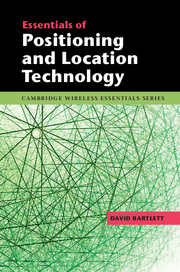Book contents
- Frontmatter
- Contents
- Miscellaneous Frontmatter
- 1 Introduction
- 2 Coordinate systems
- 3 Satellite positioning (GNSS)
- 4 Radiolocation technologies
- 5 Inertial navigation
- 6 Other techniques and hybrid systems
- 7 Techniques and performance
- 8 When things go wrong
- 9 Location-based services and applications
- 10 A brief look at the future
- References
- Index
2 - Coordinate systems
Published online by Cambridge University Press: 05 April 2013
- Frontmatter
- Contents
- Miscellaneous Frontmatter
- 1 Introduction
- 2 Coordinate systems
- 3 Satellite positioning (GNSS)
- 4 Radiolocation technologies
- 5 Inertial navigation
- 6 Other techniques and hybrid systems
- 7 Techniques and performance
- 8 When things go wrong
- 9 Location-based services and applications
- 10 A brief look at the future
- References
- Index
Summary
The two most common coordinate systems used for positioning and navigation are:
Latitude, longitude and height above mean sea level;
Cartesian systems in which (x,y,z) axes are arranged orthogonally to one another.
However, in our day-to-day lives, most position and location information is described contextually: I’m at work; I’m sitting at my desk; I’m in the car; I’m travelling south on the M1; I’m sitting next to Jim; etc. This sort of contextual information is what most applications would ideally like to have available to them, but for the purposes of computing a position or location, most locating systems work in Cartesian space (including GPS), although the resulting position may be presented as latitude, longitude and height.
Latitude and longitude
A simple definition
Latitude and Longitude are two angles used to describe a terrestrial location on the surface of the Earth. See Figure 2.1.
Latitude is measured north and south from the equator, which is an imaginary line running around the circumference of the Earth so that 90 degrees north is the north pole and 90 degrees south is the south pole. Lines of latitude run east–west linking points having the same angular measurement from the zero degree parallel, the equator.
- Type
- Chapter
- Information
- Essentials of Positioning and Location Technology , pp. 13 - 31Publisher: Cambridge University PressPrint publication year: 2013

